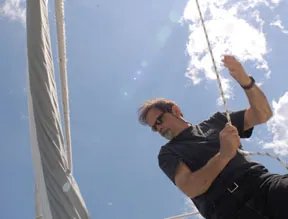Asymmetrical spinnakers – “A-sails” as many sailors have grown to refer to them – are in many respects a simplification of the conventional, symmetrical spinnaker. For both sailmakers and their customers, this is good news. With an A-sail, there’s no bothering with a spinnaker pole (though many boats these days are designed and build with bowsprits for the purpose of setting asymmetrical spinnakers), and there are fewer control lines to worry about. And not only are they simpler, A-sails are potentially much more versatile than symmetrical spinnakers. They can be flown easily through a broad range of wind angles. How low and how high you can steer with these sails is partially a function of the sail’s design, the boat’s design, and the existing sailing conditions (wind speed and sea state). But generally speaking, you can make use of an asymmetrical spinnaker from roughly 50 degrees apparent wind angle down to 130 degrees.
Asymmetrical cruising spinnakers are ordinarily constructed out of nylon, due to that material’s forgiving nature. Nylon is stronger than polyester (Dacron), so it has slightly higher resistance to tearing. It also has greater elasticity, so it can resist shock-loading. Downside? Nylon sails are more prone to sail-shaping distortion when the wind pipes up.
Most sailmakers favor a tri-radial panel orientation for cruising asymmetrical spinnakers. This is because that approach allows them to make the best use of the warp-oriented yarns in the fabric. (The warp yarns – those that run the length of the fabric – are pre-tensioned during weaving and thus don’t stretch as much as the fill yarns, those running 90 degrees in the other direction.) A proper tri-radial construction ensures that the majorloads on the sail will align with the most stretch-resistant axis of the cloth. This, too, makes these sails more versatile.
For more advice and recommendations on light-air – which to buy, when and how to use – purchase Practical Sailor’s ebook Headsails & Furling Gear.
Also, check out the complete 3 volume series, A Look at Sails at a price that’s like getting one ebook free when you buy the other two.


































